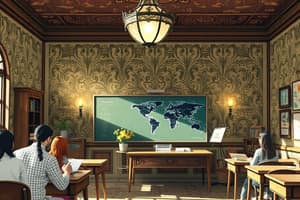Podcast
Questions and Answers
Match the key observation focus with its description:
Match the key observation focus with its description:
Teacher involvement = Teachers actively engaging with children and showing enthusiasm. Effective questioning = Predominance of open-ended questions that promote further discussion. Children's involvement = Encouraging peer-to-peer discussion and expanding on children's responses. Learning modalities = Integration of auditory, visual, and movement opportunities in activities.
Match the type of activity with its educational purpose:
Match the type of activity with its educational purpose:
Songs and stories = Auditory learning opportunities. Charts and pictures = Visual aids supporting comprehension. Dance and physical games = Movement activities promoting physical engagement. Craft supplies = Creative materials sparking curiosity and exploration.
Match the method of engagement with its outcome:
Match the method of engagement with its outcome:
Open-ended questions = Encouraging children to develop their ideas. Hands-on activities = Active manipulation leading to skill development. Peer discussions = Fostering an inclusive environment for participation. Creative materials = Keeping children engaged and interested in learning.
Match the observation area with its specific focus:
Match the observation area with its specific focus:
Match the teacher behavior with its goal:
Match the teacher behavior with its goal:
Match the children’s involvement strategy with its purpose:
Match the children’s involvement strategy with its purpose:
Match the facilitator objective with its significance:
Match the facilitator objective with its significance:
Match the educational element with its characteristic:
Match the educational element with its characteristic:
Study Notes
Effective Facilitation in Learning Environments
- Teacher Involvement: Teachers should actively engage with children by moving around the classroom, participating in activities, and showing enthusiasm.
- Responsiveness: It is important for teachers to be attentive to children's needs, providing timely and appropriate responses.
Effective Questioning
- Types of Questions: Observers focus on open-ended questions that stimulate critical thinking and expression among children.
- Promoting Discussion: Questions should lead to further discussions, allowing children to develop their ideas and explore new concepts.
Spanning Children’s Involvement
- Response to Contributions: Teachers should expand on children's answers, encouraging elaboration and peer-to-peer discussions.
- Inclusivity: Foster an inclusive environment where all children feel encouraged to participate and share their thoughts.
Variety of Modalities and Materials
- Learning Modalities: Effective integration of auditory, visual, and movement opportunities is essential in classroom activities.
- Auditory Elements: Use songs, stories, and rhymes to incorporate auditory learning.
- Visual Aids: Utilize charts, pictures, and videos to support visual learning.
- Movement Activities: Include dance, physical games, and hands-on experiments to engage children physically.
Interesting and Creative Materials
- Age-Appropriate Materials: Use materials that are not only suitable for the children's age but also engaging and creative, such as unique craft supplies and interactive tools.
- Novel Objects: Incorporate materials that spark curiosity and invite exploration, encouraging discovery.
Hands-On Opportunities
- Physical Engagement: Activities should involve active manipulation such as building, sculpting, or sorting to enhance learning.
- Development Focus: A hands-on approach is crucial for preschool learning, supporting cognitive and physical development.
Overall Assessment Standards
- By effectively integrating teacher involvement, questioning techniques, diverse modalities, and creative materials, educators can enhance learning experiences and meet assessment standards.
Studying That Suits You
Use AI to generate personalized quizzes and flashcards to suit your learning preferences.
Description
This quiz assesses the key aspects of effective facilitation during instructional learning. Observers focus on teacher involvement and engagement with children, noting enthusiasm and responsiveness to their needs. The aim is to evaluate how actively teachers participate in activities and discussions with students.



